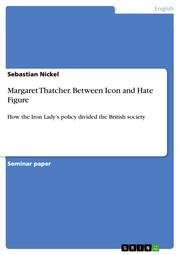Detailansicht
Margaret Thatcher. Between Icon and Hate Figure
How the Iron Ladys policy divided the British society
ISBN/EAN: 9783668818811
Umbreit-Nr.: 5923143
Sprache:
Englisch
Umfang: 24 S.
Format in cm: 0.3 x 21 x 14.8
Einband:
kartoniertes Buch
Erschienen am 10.10.2018
Auflage: 1/2018
€ 17,95
(inklusive MwSt.)
Lieferbar innerhalb 1 - 2 Wochen
- Zusatztext
- Seminar paper from the year 2016 in the subject English Language and Literature Studies - Culture and Applied Geography, grade: 2,0, University of Potsdam, language: English, abstract: In course of its long democratic history, the United Kingdom has gone through many governments whose influential Prime ministers had formed the British society. But probably no other British Prime minister (PM) has ever left his marks so much as Margaret Thatcher, who held longer office than every other PM before. However, the assumption that her almost twelve years lasting term of office could be taken as an indicator for her great popularity as great politician is not applicable at all. Indeed, the Iron Lady and her revolutionary economy and welfare policy, known as Thatcherism, polarised and still divide the minds of the British society. Whereas her supporters are prizing her policy as the basis of Britains power and wealth for millions, her critics blame her to be responsible for the ruin of the social sector and the destruction of a social community sense. This seminar paper is concerned with the controversial policy of Margaret Thatcher. For my work, I argue that The policy of Thatcher has cemented the British class system rather than loosen it. As a theoretical background I will examine the British class system and define the term class itself. The main part is structured into three linked chapters dealing with the main features of Thatchers era in order to reveal how Thatchers policy affected the major classes in the UK: Working -, Middle - and Upper Class. Thereby, it will be illustrated and concluded in the final part of this work if Thatcher can be seen rather as an icon or rather as a hate figure for the UK and its classes. The entire work is embedded in a short portray of the social life in the UK before and after Thatchers legislative period in order to compare the development objectively.
